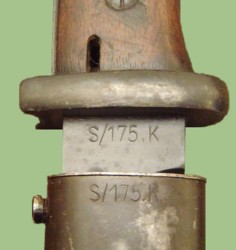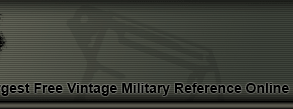The history of the WWII German K98 Bayonet -
The Karabiner 98 Kurz (often abbreviated Kar98k,
K98, or K98k) was a bolt-action rifle adopted as the standard infantry rifle in 1935 by the German
Wehrmacht, and was one of the final developments in the long line of Mauser military rifles.
The Mauser Karabiner 98k rifle was widely used by all branches of the armed forces of Germany during World War II. It saw action in every theatre of war involving German forces, including occupied Europe, North Africa, the Soviet Union, Finland, and Norway.
The 98K bayonet was designed to be mounted on the 98K Mauser rifle. There is a version of the 98K bayonet that was created for parade use only. Not meant for combat.

BAYONET ANATOMY
The design of the K98 bayonet consists of a metal pommel with a press catch button. This is a spring loaded device
whose function is to disengage the bayonet from the rifle. The button is round on one end and rectangular in the
other side. The pommel was often stamped with marks such as "eagle" shapes made of mulitple lines.
The bayonet was issued with different types of handles which are illustrated in the following photographs.
 |
 |
The bayonets came with grips manufactured of bakelite and wood. This practiced was maintained for most of the
war time.
The scabbard was made of metal. A frog stud is placed near the throat area. The finial consists of a "ball" shape
structure. It was in this section that "eagle" shapes formed by lines were commonly applied. Additional markings
on the scabbard were placed in the throat area. They included year, serial number and manufacturer's identification.
The forg was made of leather. Tropical versions, like the ones used by the Afrika Korps, were often made of khaki
color canvis. Heavy duty cotton stitching and rivets were used in the construction to increase the durability of the
frog.
|
| Wooden handle |
Bakelite handle |
|
The blade is made of blue tempered steel. It is of single edge construction for most of its length except when
it reaches the tip, then it turns into a double edge design for the last few inches. The back of the blade is
flat.

A blood groove extends and covers approximately 70 percent of the length of the blade. This feature is fairly
thick when compared to other bayonets.
The German K98 bayonets marking ssytem was very complicated. The different ways in which the bayonets could be marked
depended on the manufacturer and the year in which the item was produced. A combination of Letter codes and years
were used from 1934 to 1945in order to identify the bayonets.
 |
The bayonet consisted primarily of letters and numbers. a slash often separates one code from another. The number of
markings available is truly staggering.
The scabbard was also marked by the manufacturer. In some cases the markings were identical to those found on the
blade.
|
 |
Bayonets were marked with a "K" prefix code for the year of 1934. They were marked with a "G" prefix code for 1935. The
actual year began to be stamped in 1936 but primarily in the scabbard. The years may have been represented with the last
two digits (i.e 36 for 1936) or the entire four digits.
The quality control of the production of bayonets was so strict that even the tang of the bayonet was marked with the
production numbers. Removing the grips from a bayonet reveals how the markings were stamped. The guard plate is also
made of blue steel. Two spring flaps are present, each has holes for the screws.

| WWII GERMAN BAYONET EXAMPLES |
The more examples of a particular dagger that are examined the more knowledge is gained about the particular piece. Differences in construction can be better appreciated. Markings on the blade and other sections are better understood. The overall knowledge about the dagger is expanded.
This section of the site provides several examples of the dagger.
| WWII GERMAN BAYONET MARKINGS |
The following is a list of some of the companies that manufactured the K98 bayonet during WWII. Unlike other blades
the marking consisted of alpha numeric characters only. No manufacturer's logo was applied to the blade. The only
exception known is the Alcoso company which did apply a small logo next to the characters.
It is important to note that this may not be a complete list. The information covers bayonets known to exist
by the author. However, there may be additional variations that exist.
| Count |
Unique Makers |
Company |
Description |
Logo |
Marking Variations (1934-1936) |
| 1 |
1 |
E.u.F Horster |
S/155 |
 |
- "K" code stamped for 1934.
- "G" code stamped for 1935.
|
| 2 |
2 |
Carl Eickhorn |
S/172 |
n/a |
- "K" code stamped for 1934.
- "G" code stamped for 1935.
- "36" or "1936" marked for 1936 production
|
| 3 |
3 |
Coppel Gmbh |
S/173 |
 |
- "K" code stamped for 1934.
- "G" code stamped for 1935.
|
| 4 |
4 |
WKC |
S/174 |
 |
- "K" code stamped for 1934.
- "G" code stamped for 1935.
- "36" or "1936" marked for 1936 production
|
| 5 |
5 |
F.W. Holler |
S/175 |


|
- "K" code stamped for 1934.
- "G" code stamped for 1935.
- "36" or "1936" marked for 1936 production
|
| 6 |
6 |
Paul Weyersberg |
S/176 |
 |
- "K" code stamped for 1934.
- "G" code stamped for 1935.
|
| 7 |
7 |
E. Pack & Sohn |
S/177 |
 |
- "K" code stamped for 1934.
- "G" code stamped for 1935.
- "1936" marked for 1936
|
| 8 |
8 |
Gebr. Heller |
S/178 |
n/a |
- "K" code stamped for 1934.
- "G" code stamped for 1935.
|
| 9 |
9 |
Jos Corts |
S/184 |
n/a |
- "G" code stamped for 1935.
- "36" or "1936" marked for 1936 production
|
| 10 |
10 |
Elite Diamant |
S/185 |
 |
- "K" code stamped for 1934.
- "G" code stamped for 1935.
|
| 11 |
11 |
Durkopp |
S/238 |
n/a |
- "G" code stamped for 1935.
- "36" or "1936" marked for 1936 production
|
| 12 |
12 |
Rich Herder |
S/239 |
 |
- "36" or "1936" marked for 1936 production
|
| 13 |
13 |
F. Herder A Sn |
S/240 |
n/a |
- "36" or "1936" marked for 1936 production
|
| 14 |
14 |
Clemen & Jung |
S/241 |
n/a |
n/a |
| 15 |
15 |
Berg & Co |
S/242 |
n/a |
- "K" code stamped for 1934.
- "36" or "1936" marked for 1936 production
|
| 16 |
16 |
Mundlos |
S/244 |
n/a |
- "G" code stamped for 1935.
- "36" or "1936" marked for 1936 production
|
| 17 |
17 |
J. Sch |
S/245 |
n/a |
- "36" or "1936" marked for 1936 production
|
Additional markings exist for 1937 through 1945. These markings will be covered in eventual updates.
This information is brought to you courtesy of MilitaryItems.com. The premiere provider of military
collectibles to musuems, educational institutions and the general enthusiast.
|







